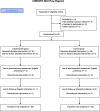Task-oriented exercises improve disability of working patients with surgically-treated proximal humeral fractures. A randomized controlled trial with one-year follow-up
- PMID: 33743670
- PMCID: PMC7981858
- DOI: 10.1186/s12891-021-04140-9
Task-oriented exercises improve disability of working patients with surgically-treated proximal humeral fractures. A randomized controlled trial with one-year follow-up
Abstract
Background: General physiotherapy is a common means of rehabilitation after surgery for proximal humeral fracture (PHF). Better-targeted exercises seem worthy of investigation and the aim of this study was to assess the efficacy of a rehabilitation program including task-oriented exercises in improving disability, pain, and quality of life in patients after a PHF.
Methods: By means of a randomized controlled trial with one-year follow-up, 70 working patients (mean age of 49 ± 11 years; 41 females), who were selected for open reduction and internal fixation with plates caused by PHF, were randomized to be included in an experimental (n = 35) or control group (n = 35). There was a permuted-block randomization plan, and a list of program codes was previously created; subsequently, an automatic assignment system was used to conceal the allocation. The first group underwent a supervised rehabilitation program of task-oriented exercises based on patients' specific job activities, and occupational therapy. The second group underwent general physiotherapy, including supervised mobility, strengthening and stretching exercises. Both groups individually followed programs of 60-min session three times per week for 12 weeks in the outpatient setting. The Disability Arm Shoulder Hand questionnaire (DASH; scores range from 0 to 100; primary outcome), a Pain intensity Numerical Rating Scale (scores range 0 to 10; secondary outcomes), and the Short-Form Health Survey (scores range from 0 to 100; secondary outcomes) assessed the interventions. Participants were evaluated before surgery, before and after rehabilitation (primary endpoint), and at the one-year follow-up (secondary endpoint). A linear mixed model analysis for repeated measures was carried out for each outcome measure (p < 0.05).
Results: Time, group and time by group showed significant effects for all outcome measures in favour of the experimental group. The DASH and the DASH work achieved clinically important between-group differences of 16.0 points (95% confidence interval [C.I.] 7.3 to 24.7) and 19.7 (95% C.I. 9.0 to 30.5) at follow-up, respectively. The NRS achieved a between-group difference of 2.9 (95% C.I. 1.0 to 3.9) at follow-up. As for SF-36, there were between-group differences ranging from 17.9 to 37.0 at follow-up.
Conclusions: A rehabilitation program based on task-oriented exercises was useful in improving disability, pain, and quality of life in working patients after PHFs. Improvements lasted for at least 12 months.
Trial registration: On 16/12/2019, the trial was retrospectively registered in the ISRCTN registry with the ID number 17996552 .
Keywords: Proximal humeral fractures; Rehabilitation; Surgery; Task-oriented exercises.
Conflict of interest statement
The authors declare they have no competing interests.
Figures
Comment in
-
Critically appraised paper: Task-oriented exercise improved disability, pain and quality of life compared with general physiotherapy for surgically treated proximal humeral fractures [synopsis].J Physiother. 2022 Jan;68(1):72. doi: 10.1016/j.jphys.2021.11.007. Epub 2021 Dec 8. J Physiother. 2022. PMID: 34895874 No abstract available.
-
Critically appraised paper: Task-oriented exercise improved disability, pain and quality of life compared with general physiotherapy for surgically treated proximal humeral fractures [commentary].J Physiother. 2022 Jan;68(1):72. doi: 10.1016/j.jphys.2021.11.008. Epub 2021 Dec 8. J Physiother. 2022. PMID: 34895879 No abstract available.
References
-
- Kim SH, Szabo RM, Marder RA. Epidemiology of humerus fractures in the United States: nationwide emergency department sample, 2008. Arthritis Care Res 2012;64(3):407–414, https://doi.org/10.1002/acr.21563. - PubMed
-
- Launonen AP, Lepola V, Saranko A, Flinkkilä T, Laitinen M, Mattila VM. Epidemiology of proximal humerus fractures. Arch Osteoporos 2015;10:2, https://doi.org/10.1007/s11657-015-0209-4. - PubMed
-
- Dauwe J, Walters G, Holzer LA, Vanhaecht K, Nijs S. Failure after proximal humeral fracture osteosynthesis: a one year analysis of hospital-related healthcare cost. Int Orthop 2020;44:1217–1221. https://doi.org/10.1007/s00264-020-04577-y. - PMC - PubMed
-
- Leigh JP. Economic burden of occupational injury and illness in the United States. Milbank Q 2011;89:728–772, https://doi.org/10.1111/j.1468-0009.2011.00648.x. - PMC - PubMed
-
- Häussler B, Gothe H, Göl D, Glaeske G, Pientka L, Felsenberg D. Epidemiology, treatment and costs of osteoporosis in Germany—the BoneEVA study. Osteoporos Int 2007;18(1):77–84, https://doi.org/10.1007/s00198-006-0206-y. - PubMed
Publication types
MeSH terms
LinkOut - more resources
Full Text Sources
Other Literature Sources
Medical
Research Materials



